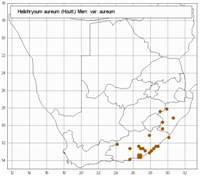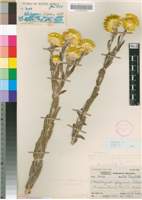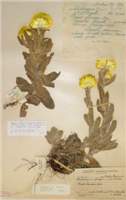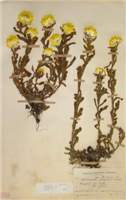Origin of name:
aureus / -a/ -um = golden
Diagnostic characters:
Leaf margins woolly
Large solitary heads
Sunny-yellow bracts
Description:
Perennial herb, flowering stems c. 150�800 mm high, simple or sparingly forked above, loosely white-woolly or cottony, very variable in stature, in leaf-size and indumentum, and in head size, stock becoming very stout and woody, crown up to c. 25 mm diam. producing one or several leaf rosettes, flowering stems several, lateral to the rosettes, c. 100�400 (�800) mm high, simple or sparingly branched towards the top, branches simple, glandular-setose, often cobwebby or loosely white-woolly as well, leafy throughout. Radical leaves c. 70�100 (�270) x 10�25 (�60) mm, narrowly or broadly elliptic-spathulate, apex obtuse to subacute, base broad, clasping, very thinly to densely greyish-white woolly above and below, wool sometimes eventually confined to margins and main veins; cauline leaves up to 70 (�100) x 15 (�20) mm, decreasing in size upwards, oblong, oblong-lanceolate to lanceolate upwards, correspondingly obtuse, acute to acuminate, apiculate, base more or less cordate-clasping, very shortly decurrent in the larger leaves, glandular-setose, often cobwebby or lightly woolly at first, wool later confined to margins and main veins. Heads heterogamous, depressed-globose, 16�20 mm long, c. 35�45 mm across the radiating bracts, solitary or up to 6 racemosely or subcorymbosely arranged at the stem tip on long or short leafy peduncles. Involucral bracts in c. 7�9 series, graded, imbricate, much exceeding flowers, radiating, glossy, yellow, outer becoming brownish with age. Receptacle scarcely honeycombed. Flowers 1488�1642, 199�284 female, 1204�1443 homogamous, yellow. Achenes 0,75�1 mm long, barrel-shaped, glabrous. Pappus bristles many, equaling corolla, tips barbellate, bases with patent cilia not or scarcely cohering.
Flowering mainly between July and November.
Distribution:
Grows in grassland or short scrub. Ranges from about Sezela on the KwaZulu-Natal coast south of Durban to about Humansdorp in the Eastern Cape, and inland to Tabankulu Mountain, Transkei, and the Stutterheim area, the Amatola Mountains, Boschberg and the Koudeveld Mountains.
Savanna, Grassland, Fynbos and Thicket Biomes.
Notes:
Six varieties are recognized:
la Involucral bracts yellow, outer sometimes pale brown or buff:
2a Heads mostly 15�20 mm long measured from base of outer involucral bracts to tips of longest inner ones, c. 35�45 mm across the fully radiating involucral bracts; if only 30 mm across, then on cliffs in the Drakensberg:
3a Flowering stems loosely woolly or cobwebby mostly throughout; flowering mainly between August and December:
4a Plants growing in grassland or scrub:
5a Cauline leaves only very lightly woolly, or wool confined to margins and midline
(a) var. aureum
5b Cauline leaves thickly and persistently silver-grey woolly
(f) var. argenteum
4b Plants growing on cliff faces or on rocky terrain immediately below cliffs in the Drakensberg
(b) var. scopulosum
3b Flowering stems woolly or cobwebby only in the uppermost part, flowering mainly between January and April
(c) var. serotinum
2b Heads mostly 8�15 mm long, up to 32 mm across the radiating bracts, growing in grassland
(d) var. monocephalum
1b Involucral bracts snow-white
(e) var. candidum
The distinguishing features of var. aureum are the large heads and green, woolly-margined cauline leaves. Much of the E. Cape coastal material in herbaria lacks radical leaves, but these, when present, may be green with woolly margins or thickly to thinly grey-woolly. The original material of H. aureum probably came from the Humansdorp-Port Elizabeth area, the furthest east that Thunberg collected, and radical leaves are wanting on his specimens. Plants from coastal Natal, whence came Dr�ge's specimen of H. fulgidum var. heterotrichum, have grey-woolly radical leaves and green cauline leaves. It seems that variation in the indumentum of the radical leaves must be accepted as characteristic of var. aureum.
Taxonomy:
Literature:
Helichrysum aureum (Houtt.) Merrill in J. Arnold Arb. 19: 372 (1938); Hilliard, Compositae in Natal 249 (1977).
Type:
Cape, Thunberg (specimen given by Thunberg to Houttuyn now in herbarium Burmann, G).
Synonym(s):
Gnaphalium aureum Houtt., Nat. Hist. 2, fasc. 10: 590, t. 67, fig. 3 (1779).
Xeranthemum fulgidum L. f., Suppl. 365 (1781); Curtis's Bot. Mag. t. 414 (1798). Helichrysum fulgidum (L. f.) Willd., Sp. Pl. 3: 1904 (1804); Thunberg, Fl. Cap. 664 (1823); Less., Syn. Comp. 285 (1832); DC., Prodr. 6: 187 (1838); Harv. in F.C. 3: 232 (1865); Moeser in Bot. Jb. 44: 338 (1910). Gnaphalium fulgidum (L. f.) Zuccagni in Roem., Collect. 153 (1809). Type: Cape of Good Hope, Thunberg (LINN 990.23).
Helichrysum fulgidum var. angustifolium DC., Prodr. 6: 187 (1838). Type: Eastern Cape, Albany, Dr�ge 3739 (G-DC, holo.).
H. fulgidum var. heterotrichum DC., Prodr. 6: 187 (1838). Type: KwaZulu-Natal, between Umkomaas and Umzimkulu Rivers, Dr�ge 5021 (G-DC, holo.; BM; E; K; TCD, iso.).
Vouchers:
Acocks 9142 (PRE); Bayliss 2346 (NBG); Flanagan 869 (PRE); Hilliard & Burtt 10954 (E; K; MO; NU; S); Pegler 676 (PRE).



